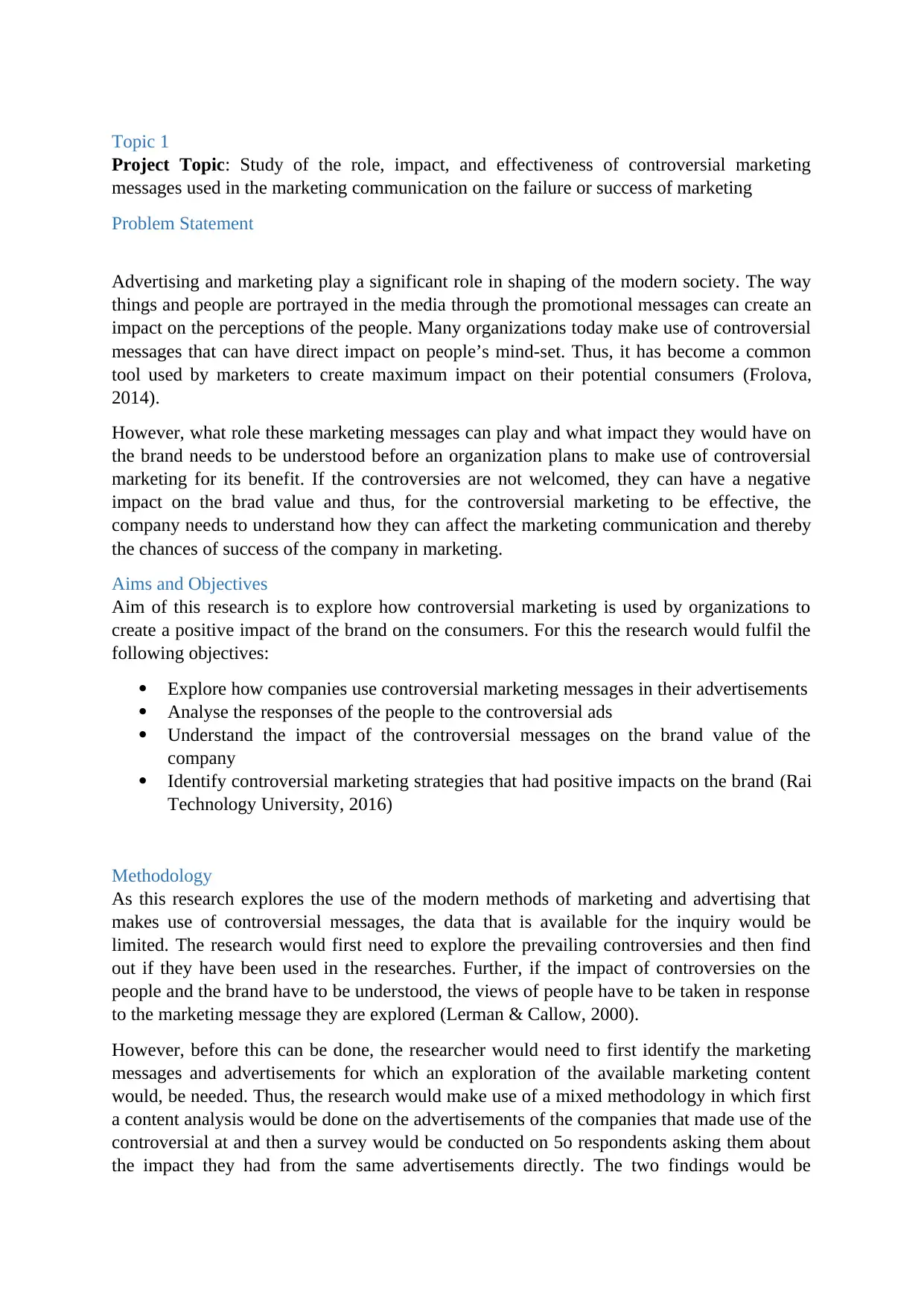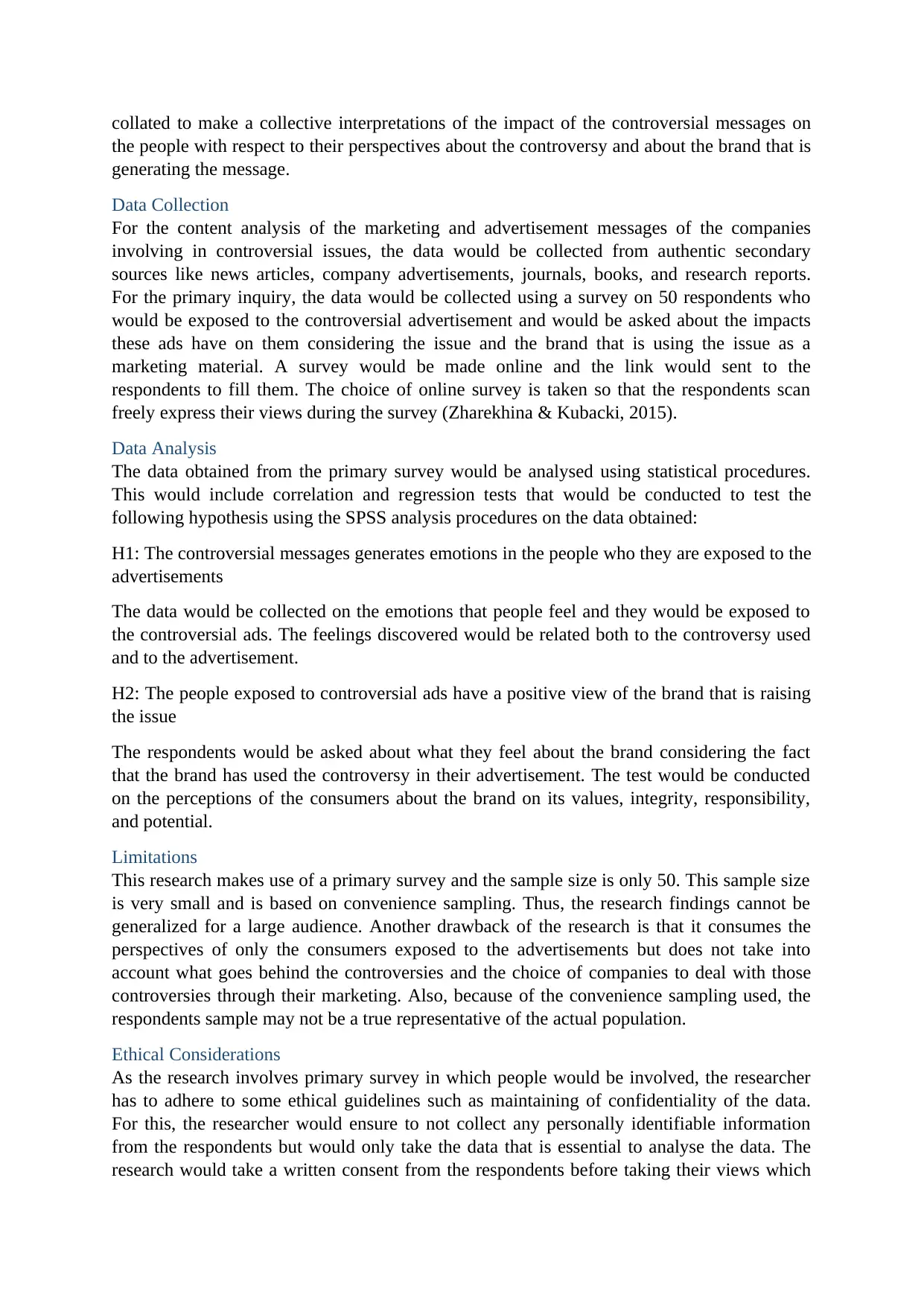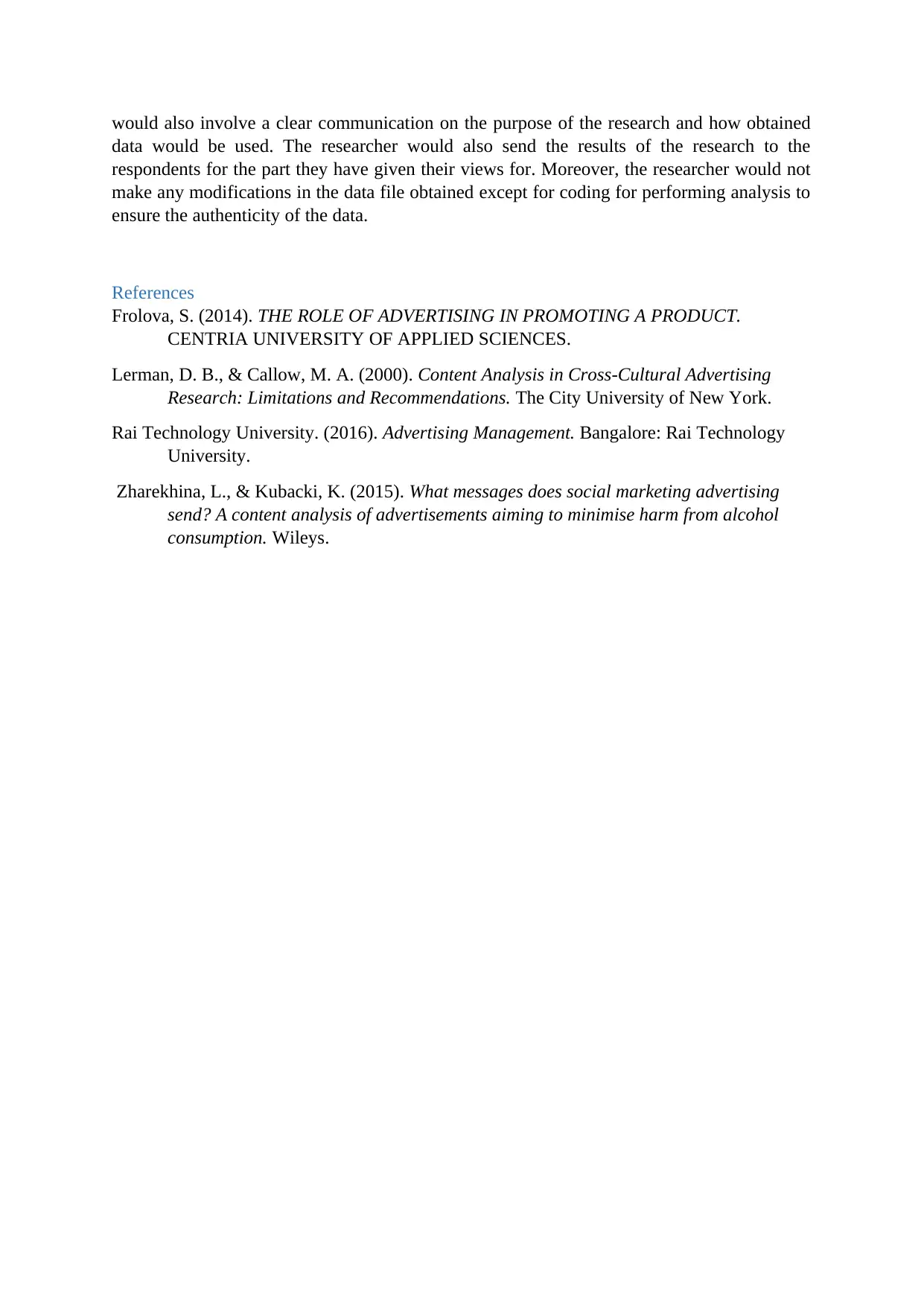Rai University Marketing Project: Controversial Marketing Impact
VerifiedAdded on 2021/04/17
|3
|1200
|49
Project
AI Summary
This project explores the role, impact, and effectiveness of controversial marketing messages in advertising, examining their influence on brand success or failure. The research aims to understand how companies use controversial messages, analyze consumer responses, and determine the impact on brand value. The methodology involves a mixed-methods approach, including content analysis of advertisements and a survey of 50 respondents. Data will be collected from secondary sources like news articles and primary sources via an online survey. Statistical analysis, including correlation and regression tests, will be used to test hypotheses related to emotional responses and brand perception. The research acknowledges limitations such as a small sample size and potential for convenience sampling bias, while adhering to ethical guidelines, including confidentiality and informed consent. The project aims to provide insights into effective controversial marketing strategies while considering ethical implications.

Topic 1
Project Topic: Study of the role, impact, and effectiveness of controversial marketing
messages used in the marketing communication on the failure or success of marketing
Problem Statement
Advertising and marketing play a significant role in shaping of the modern society. The way
things and people are portrayed in the media through the promotional messages can create an
impact on the perceptions of the people. Many organizations today make use of controversial
messages that can have direct impact on people’s mind-set. Thus, it has become a common
tool used by marketers to create maximum impact on their potential consumers (Frolova,
2014).
However, what role these marketing messages can play and what impact they would have on
the brand needs to be understood before an organization plans to make use of controversial
marketing for its benefit. If the controversies are not welcomed, they can have a negative
impact on the brad value and thus, for the controversial marketing to be effective, the
company needs to understand how they can affect the marketing communication and thereby
the chances of success of the company in marketing.
Aims and Objectives
Aim of this research is to explore how controversial marketing is used by organizations to
create a positive impact of the brand on the consumers. For this the research would fulfil the
following objectives:
Explore how companies use controversial marketing messages in their advertisements
Analyse the responses of the people to the controversial ads
Understand the impact of the controversial messages on the brand value of the
company
Identify controversial marketing strategies that had positive impacts on the brand (Rai
Technology University, 2016)
Methodology
As this research explores the use of the modern methods of marketing and advertising that
makes use of controversial messages, the data that is available for the inquiry would be
limited. The research would first need to explore the prevailing controversies and then find
out if they have been used in the researches. Further, if the impact of controversies on the
people and the brand have to be understood, the views of people have to be taken in response
to the marketing message they are explored (Lerman & Callow, 2000).
However, before this can be done, the researcher would need to first identify the marketing
messages and advertisements for which an exploration of the available marketing content
would, be needed. Thus, the research would make use of a mixed methodology in which first
a content analysis would be done on the advertisements of the companies that made use of the
controversial at and then a survey would be conducted on 5o respondents asking them about
the impact they had from the same advertisements directly. The two findings would be
Project Topic: Study of the role, impact, and effectiveness of controversial marketing
messages used in the marketing communication on the failure or success of marketing
Problem Statement
Advertising and marketing play a significant role in shaping of the modern society. The way
things and people are portrayed in the media through the promotional messages can create an
impact on the perceptions of the people. Many organizations today make use of controversial
messages that can have direct impact on people’s mind-set. Thus, it has become a common
tool used by marketers to create maximum impact on their potential consumers (Frolova,
2014).
However, what role these marketing messages can play and what impact they would have on
the brand needs to be understood before an organization plans to make use of controversial
marketing for its benefit. If the controversies are not welcomed, they can have a negative
impact on the brad value and thus, for the controversial marketing to be effective, the
company needs to understand how they can affect the marketing communication and thereby
the chances of success of the company in marketing.
Aims and Objectives
Aim of this research is to explore how controversial marketing is used by organizations to
create a positive impact of the brand on the consumers. For this the research would fulfil the
following objectives:
Explore how companies use controversial marketing messages in their advertisements
Analyse the responses of the people to the controversial ads
Understand the impact of the controversial messages on the brand value of the
company
Identify controversial marketing strategies that had positive impacts on the brand (Rai
Technology University, 2016)
Methodology
As this research explores the use of the modern methods of marketing and advertising that
makes use of controversial messages, the data that is available for the inquiry would be
limited. The research would first need to explore the prevailing controversies and then find
out if they have been used in the researches. Further, if the impact of controversies on the
people and the brand have to be understood, the views of people have to be taken in response
to the marketing message they are explored (Lerman & Callow, 2000).
However, before this can be done, the researcher would need to first identify the marketing
messages and advertisements for which an exploration of the available marketing content
would, be needed. Thus, the research would make use of a mixed methodology in which first
a content analysis would be done on the advertisements of the companies that made use of the
controversial at and then a survey would be conducted on 5o respondents asking them about
the impact they had from the same advertisements directly. The two findings would be
Paraphrase This Document
Need a fresh take? Get an instant paraphrase of this document with our AI Paraphraser

collated to make a collective interpretations of the impact of the controversial messages on
the people with respect to their perspectives about the controversy and about the brand that is
generating the message.
Data Collection
For the content analysis of the marketing and advertisement messages of the companies
involving in controversial issues, the data would be collected from authentic secondary
sources like news articles, company advertisements, journals, books, and research reports.
For the primary inquiry, the data would be collected using a survey on 50 respondents who
would be exposed to the controversial advertisement and would be asked about the impacts
these ads have on them considering the issue and the brand that is using the issue as a
marketing material. A survey would be made online and the link would sent to the
respondents to fill them. The choice of online survey is taken so that the respondents scan
freely express their views during the survey (Zharekhina & Kubacki, 2015).
Data Analysis
The data obtained from the primary survey would be analysed using statistical procedures.
This would include correlation and regression tests that would be conducted to test the
following hypothesis using the SPSS analysis procedures on the data obtained:
H1: The controversial messages generates emotions in the people who they are exposed to the
advertisements
The data would be collected on the emotions that people feel and they would be exposed to
the controversial ads. The feelings discovered would be related both to the controversy used
and to the advertisement.
H2: The people exposed to controversial ads have a positive view of the brand that is raising
the issue
The respondents would be asked about what they feel about the brand considering the fact
that the brand has used the controversy in their advertisement. The test would be conducted
on the perceptions of the consumers about the brand on its values, integrity, responsibility,
and potential.
Limitations
This research makes use of a primary survey and the sample size is only 50. This sample size
is very small and is based on convenience sampling. Thus, the research findings cannot be
generalized for a large audience. Another drawback of the research is that it consumes the
perspectives of only the consumers exposed to the advertisements but does not take into
account what goes behind the controversies and the choice of companies to deal with those
controversies through their marketing. Also, because of the convenience sampling used, the
respondents sample may not be a true representative of the actual population.
Ethical Considerations
As the research involves primary survey in which people would be involved, the researcher
has to adhere to some ethical guidelines such as maintaining of confidentiality of the data.
For this, the researcher would ensure to not collect any personally identifiable information
from the respondents but would only take the data that is essential to analyse the data. The
research would take a written consent from the respondents before taking their views which
the people with respect to their perspectives about the controversy and about the brand that is
generating the message.
Data Collection
For the content analysis of the marketing and advertisement messages of the companies
involving in controversial issues, the data would be collected from authentic secondary
sources like news articles, company advertisements, journals, books, and research reports.
For the primary inquiry, the data would be collected using a survey on 50 respondents who
would be exposed to the controversial advertisement and would be asked about the impacts
these ads have on them considering the issue and the brand that is using the issue as a
marketing material. A survey would be made online and the link would sent to the
respondents to fill them. The choice of online survey is taken so that the respondents scan
freely express their views during the survey (Zharekhina & Kubacki, 2015).
Data Analysis
The data obtained from the primary survey would be analysed using statistical procedures.
This would include correlation and regression tests that would be conducted to test the
following hypothesis using the SPSS analysis procedures on the data obtained:
H1: The controversial messages generates emotions in the people who they are exposed to the
advertisements
The data would be collected on the emotions that people feel and they would be exposed to
the controversial ads. The feelings discovered would be related both to the controversy used
and to the advertisement.
H2: The people exposed to controversial ads have a positive view of the brand that is raising
the issue
The respondents would be asked about what they feel about the brand considering the fact
that the brand has used the controversy in their advertisement. The test would be conducted
on the perceptions of the consumers about the brand on its values, integrity, responsibility,
and potential.
Limitations
This research makes use of a primary survey and the sample size is only 50. This sample size
is very small and is based on convenience sampling. Thus, the research findings cannot be
generalized for a large audience. Another drawback of the research is that it consumes the
perspectives of only the consumers exposed to the advertisements but does not take into
account what goes behind the controversies and the choice of companies to deal with those
controversies through their marketing. Also, because of the convenience sampling used, the
respondents sample may not be a true representative of the actual population.
Ethical Considerations
As the research involves primary survey in which people would be involved, the researcher
has to adhere to some ethical guidelines such as maintaining of confidentiality of the data.
For this, the researcher would ensure to not collect any personally identifiable information
from the respondents but would only take the data that is essential to analyse the data. The
research would take a written consent from the respondents before taking their views which

would also involve a clear communication on the purpose of the research and how obtained
data would be used. The researcher would also send the results of the research to the
respondents for the part they have given their views for. Moreover, the researcher would not
make any modifications in the data file obtained except for coding for performing analysis to
ensure the authenticity of the data.
References
Frolova, S. (2014). THE ROLE OF ADVERTISING IN PROMOTING A PRODUCT.
CENTRIA UNIVERSITY OF APPLIED SCIENCES.
Lerman, D. B., & Callow, M. A. (2000). Content Analysis in Cross-Cultural Advertising
Research: Limitations and Recommendations. The City University of New York.
Rai Technology University. (2016). Advertising Management. Bangalore: Rai Technology
University.
Zharekhina, L., & Kubacki, K. (2015). What messages does social marketing advertising
send? A content analysis of advertisements aiming to minimise harm from alcohol
consumption. Wileys.
data would be used. The researcher would also send the results of the research to the
respondents for the part they have given their views for. Moreover, the researcher would not
make any modifications in the data file obtained except for coding for performing analysis to
ensure the authenticity of the data.
References
Frolova, S. (2014). THE ROLE OF ADVERTISING IN PROMOTING A PRODUCT.
CENTRIA UNIVERSITY OF APPLIED SCIENCES.
Lerman, D. B., & Callow, M. A. (2000). Content Analysis in Cross-Cultural Advertising
Research: Limitations and Recommendations. The City University of New York.
Rai Technology University. (2016). Advertising Management. Bangalore: Rai Technology
University.
Zharekhina, L., & Kubacki, K. (2015). What messages does social marketing advertising
send? A content analysis of advertisements aiming to minimise harm from alcohol
consumption. Wileys.
⊘ This is a preview!⊘
Do you want full access?
Subscribe today to unlock all pages.

Trusted by 1+ million students worldwide
1 out of 3
Related Documents
Your All-in-One AI-Powered Toolkit for Academic Success.
+13062052269
info@desklib.com
Available 24*7 on WhatsApp / Email
![[object Object]](/_next/static/media/star-bottom.7253800d.svg)
Unlock your academic potential
Copyright © 2020–2025 A2Z Services. All Rights Reserved. Developed and managed by ZUCOL.





